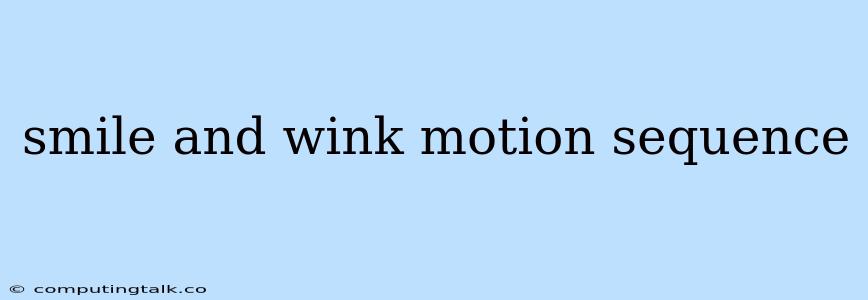A smile and wink is a universal gesture of flirtation and playfulness. It conveys a mix of warmth, amusement, and interest. Mastering this sequence can enhance your communication skills and add a touch of charm to your interactions.
Understanding the Smile and Wink
The smile and wink is a powerful nonverbal cue that requires a specific sequence of motions to achieve its desired effect. Here's a breakdown of the key components:
The Smile:
- Genuine vs. Fake: A genuine smile engages multiple facial muscles, including those around the eyes, creating a crinkle at the corners. A fake smile, on the other hand, only involves the mouth, appearing strained and forced.
- Intensity and Duration: The intensity of your smile should match the situation and your relationship with the recipient. A gentle smile is appropriate for casual encounters, while a broader smile is suitable for expressing genuine happiness or attraction. The duration of the smile should be brief, lasting only a few seconds.
The Wink:
- Eye Closure: A proper wink involves quickly closing one eye while keeping the other open. The closed eye should remain shut for a fraction of a second, then swiftly reopen.
- Speed and Timing: The speed of the wink is important. A slow wink can appear deliberate or even menacing, while a rapid wink conveys playfulness and a sense of secrecy. The timing is crucial, as a wink delivered too early or too late can lose its impact.
Practicing the Smile and Wink Motion Sequence:
- Mirror Practice: Practice the smile and wink sequence in front of a mirror. This allows you to see how your facial muscles are working and adjust the intensity and timing of your movements.
- Subtlety is Key: The goal is to create a natural-looking sequence that doesn't appear forced or overly exaggerated. Practice in a relaxed setting to build confidence and refine your technique.
- Focus on the Eyes: The eyes are the window to the soul. Your eyes should convey a sense of warmth, humor, and intrigue. Look directly at the recipient when you smile and wink, making eye contact before and after the wink.
Common Mistakes to Avoid:
- Forced Smile: A fake smile can appear insincere and even off-putting. Aim for a genuine and natural smile.
- Overly Exaggerated Wink: A wink that is too long or too frequent can be distracting and come across as insincere. Practice a quick and subtle wink.
- Incorrect Timing: The timing of the wink is crucial. It should be delivered after the smile, creating a playful and unexpected element.
Situational Variations:
The smile and wink motion sequence can be adapted to different situations and relationships.
- Romantic Context: In a romantic setting, a smile and wink can express attraction, playful teasing, and a desire for connection.
- Social Setting: A subtle smile and wink can be used to break the ice, show appreciation, or indicate shared humor.
- Professional Setting: In a professional context, the smile and wink should be used sparingly, as it can be misconstrued as inappropriate or unprofessional.
Cultural Considerations:
It's essential to be aware of cultural nuances when using a smile and wink. What may be considered flirtatious in one culture could be offensive in another. Observe and learn from local customs and etiquette.
Conclusion:
Mastering the smile and wink motion sequence can add a layer of charm and personality to your interactions. By understanding the elements involved, practicing the technique, and considering cultural sensitivity, you can effectively use this gesture to convey a range of emotions and intentions. Remember, the key is to be genuine, playful, and confident.
